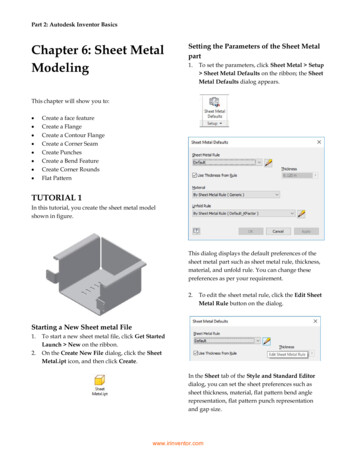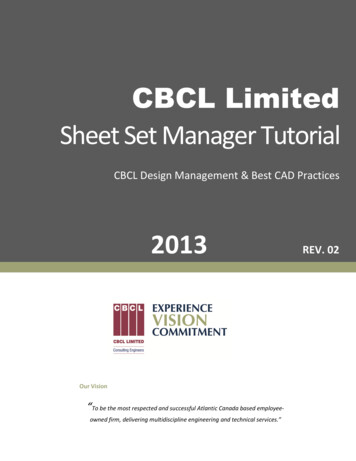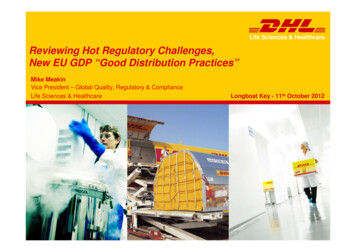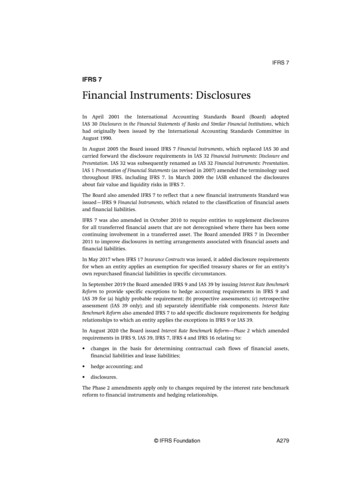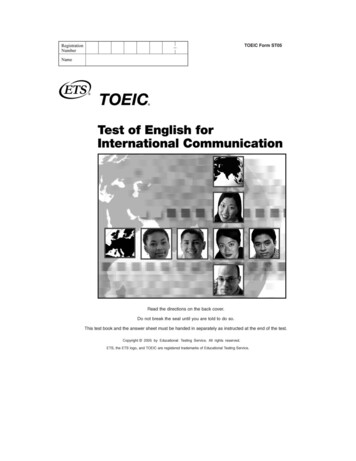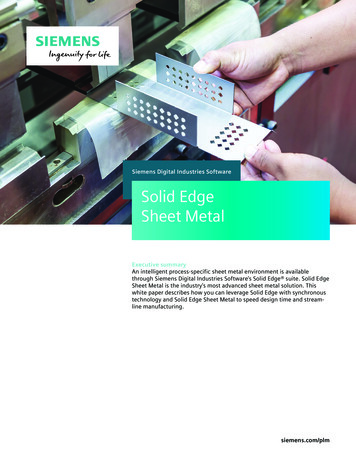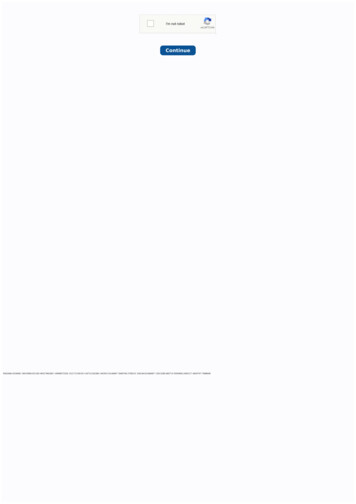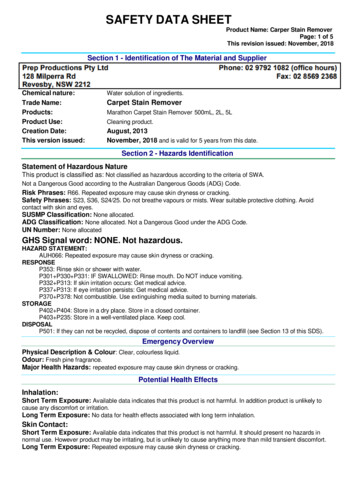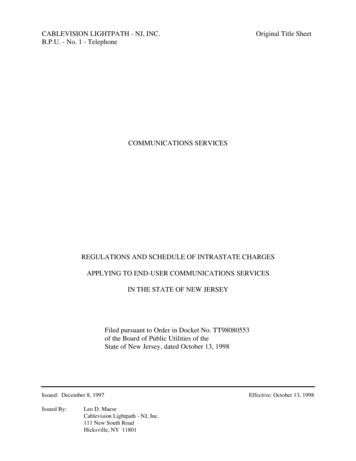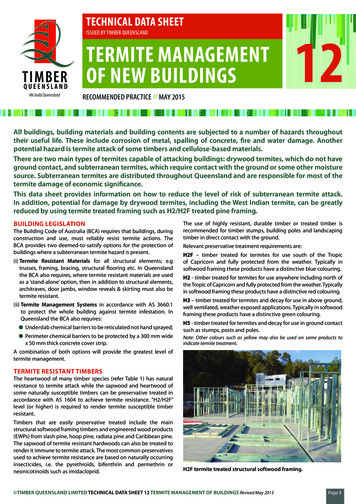
Transcription
TECHNICAL DATA SHEETISSUED BY TIMBER QUEENSLANDTERMITE MANAGEMENTOF NEW BUILDINGSRECOMMENDED PRACTICE // MAY 201512All buildings, building materials and building contents are subjected to a number of hazards throughouttheir useful life. These include corrosion of metal, spalling of concrete, fire and water damage. Anotherpotential hazard is termite attack of some timbers and cellulose-based materials.There are two main types of termites capable of attacking buildings: drywood termites, which do not haveground contact, and subterranean termites, which require contact with the ground or some other moisturesource. Subterranean termites are distributed throughout Queensland and are responsible for most of thetermite damage of economic significance.This data sheet provides information on how to reduce the level of risk of subterranean termite attack.In addition, potential for damage by drywood termites, including the West Indian termite, can be greatlyreduced by using termite treated framing such as H2/H2F treated pine framing.BUILDING LEGISLATIONThe Building Code of Australia (BCA) requires that buildings, duringconstruction and use, must reliably resist termite actions. TheBCA provides two deemed-to-satisfy options for the protection ofbuildings where a subterranean termite hazard is present.(i) Termite Resistant Materials for all structural elements; e.gtrusses, framing, bracing, structural flooring etc. In Queenslandthe BCA also requires, where termite resistant materials are usedas a ‘stand-alone’ option, then in addition to structural elements,architraves, door jambs, window reveals & skirting must also betermite resistant.(ii) Termite Management Systems in accordance with AS 3660.1to protect the whole building against termite infestation. InQueensland the BCA also requires: Underslab chemical barriers to be reticulated not hand sprayed; Perimeter chemical barriers to be protected by a 300 mm widex 50 mm thick concrete cover strip.The use of highly resistant, durable timber or treated timber isrecommended for timber stumps, building poles and landscapingtimber in direct contact with the ground.Relevant preservative treatment requirements are:H2F – timber treated for termites for use south of the Tropicof Capricorn and fully protected from the weather. Typically insoftwood framing these products have a distinctive blue colouring.H2 - timber treated for termites for use anywhere including north ofthe Tropic of Capricorn and fully protected from the weather. Typicallyin softwood framing these products have a distinctive red colouring.H3 – timber treated for termites and decay for use in above ground,well ventilated, weather exposed applications. Typically in softwoodframing these products have a distinctive green colouring.H5 - timber treated for termites and decay for use in ground contactsuch as stumps, posts and poles.Note: Other colours such as yellow may also be used on some products toindicate termite treatment.A combination of both options will provide the greatest level oftermite management.TERMITE RESISTANT TIMBERSThe heartwood of many timber species (refer Table 1) has naturalresistance to termite attack while the sapwood and heartwood ofsome naturally susceptible timbers can be preservative treated inaccordance with AS 1604 to achieve termite resistance. “H2/H2F”level (or higher) is required to render termite susceptible timberresistant.Timbers that are easily preservative treated include the mainstructural softwood framing timbers and engineered wood products(EWPs) from slash pine, hoop pine, radiata pine and Caribbean pine.The sapwood of termite resistant hardwoods can also be treated torender it immune to termite attack. The most common preservativesused to achieve termite resistance are based on naturally occurringinsecticides, i.e. the pyrethroids, bifenthrin and permethrin orneonicotinoids such as imidacloprid.H2F termite treated structural softwood framing. TIMBER QUEENSLAND LIMITED TECHNICAL DATA SHEET 12 TERMITE MANAGEMENT OF BUILDINGS Revised May 2015Page 1
or possible then the in-situ preservative treatment of termitesusceptible timber should be considered.Suitable brush-on or spray-on preservative treatments for termitesusceptible timber used for protected framing are listed below,Protim Solignum “XJ Clear”. (See Figure 1) Tanalized “Ecoseal” or “Enseal Clear”. (See Figure 2)H2 termite treated structural softwood framing.TABLE 1 - TERMITE RESISTANT TIMBERS (SEE NOTES)In-Ground and Above Ground1red bloodwoodgrey boxforest red gumironbark (all species)white mahoganyGympie messmatetallowwoodturpentineslash pine2/3hoop pine²radiata pine2Caribbean pine2/3Above Ground Onlyblackbuttspotted gumred mahoganywhite stringybarkcypressNotes:1) The sapwood of these species is to be treated to ‘H5’ level for in-ground use,‘H3’ level for weather exposed above ground use and ‘H2/H2F’ level for fullyprotected, above ground applications.2) The heartwood of these softwoods is to be limited 20% of the cross-sectionalarea in all weather exposed applications.3) The heartwood of slash and Caribbean pine is rated termite resistant, andtherefore does not need to be limited to 20% for fully protected, above groundapplications.H2F TIMBER BUILDING PRACTICETermite resistant timber shall be installed, used and maintained inaccordance with the building practice requirements of AustralianStandard AS 1684 “Residential timber-framed construction.” In H2Ftimbers termite resistance is dependant upon the integrity of thepreservative envelope. Research has shown that a trimmed end,abutting a treated surface does not adversely affect the termiteresistance of the timber. Similarly minor notching, trenching anddrilling of holes in accordance with the requirements of AS1684.2Clause 6.2.1.4 is considered acceptable.Practical building situations however can arise, during construction,which may necessitate the removal of the preservative envelopebeyond the limits of AS1684. E.g.1) Recessing of metal bracing products2) Rebates to accommodate showers or baths3) Stud straightening by planning of stud mid sections4) Inadvertent damage to membersWhere the exposed surface area of termite susceptible timberexceeds the cross sectional area of the member concerned,then additional termite protection is required to achieve theperformance requirements of the BCA relating to termite action.Where replacement of the affected timber member is not practicalFigure 1.Protim Solignum XJ Clear.Figure 2.Tanalized Ecoseal & Enseal.These site applied preservatives may also be required for use with H2and H3 treated timber. For H4 and H5 treated timber copper napthenateoils and omulsions are recommended. Check timber and preservativemanufacturer’s recommendations for specific requirements.MINIMIZING THE RISK(Prevention is better than the cure)The risk of termite attack on buildings has increased with the changeto construction methods dominated by concrete ‘slab on ground’and masonry enclosed sub-floorsIn addition to the use of termite resistant timbers, where buildingowners seek greater security, and additional protection for thebuilding and the contents, it can be provided by the use of termitemanagement systems using sheet, chemical, or granular materialsbut most require on-going maintenance and regular inspections toensure integrity.The use of termite resistant timber may also be appropriate wherefuture maintenance and inspections will be difficult or unlikely to becarried out.For traditional Queensland construction (i.e. using timber floors offthe ground), termite management is easily afforded by incorporatingphysical protection into the design, coupled with regular inspection.Queensland’s rich heritage of timber buildings is testimony to theeffectiveness of these measures.BUILDING TERMITE MANAGEMENT SYSTEMSAS 3660.1 provides a range of options for termite managementof new buildings from subterranean termites. Figures 3 and 4summarise these for timber floors and monolithic slab on groundconstruction respectively.N.B: Where the concrete slab is not monolithic in accordance withAS 2870, full under-slab chemical (reticulated in Qld) or physicalmanagement systems may be required.Ant Caps (Termite Shields)These are physical management systems that are inserted betweenthe lowest floor framing timbers and the supporting stumps,brickwork, piers etc. They are usually formed from corrosive resistantsheet metal or mesh and are designed to force the termites outinto the open and to allow physical inspection and simple, earlydetection and eradication of termite activity. TIMBER QUEENSLAND LIMITED TECHNICAL DATA SHEET 12 TERMITE MANAGEMENT OF BUILDINGS Revised May 2015Page 2
25 mm min clearance.Termite Shield(Ant cap)25 mm min clearance.Termite resistant supportBearerTermiteShield150 mm min.400mm minPost surround options1. Chemical soil barrier2. Stainless steel meshsock3. Crushed granitesurround to postTermite resistantsupport2000 maximumExternal Perimeter options1. Chemical (Trenched or reticulated - Queensland)2. Stainless steel mesh (to manufacturers spec.)3. Graded stone (to manufacturers spec.)(a) Metal shields(b) Alternative systemsFIGURE 3TERMITE MANAGEMENT SYSTEMS FOR SUSPENDED TIMBER FLOORSNOTE: All systems require regular inspections (not greater than 12 month intervals).Monolithic slabto AS 2870.1Flashing / DPCFlashing / DPCWeep HoleMonolithic slabto AS 2870.1Weep HoleSlab edge exposed75 mm min.Vapour BarrierCapping materialStrip shieldingpenetrating 35 mmto 50 mm intograded stone25 mm min.VapourBarrier75 mmmin.Service pipe collaredwith graded stone75 mm min. deepGraded stone(a) Exposed EdgePenetration protected by1. Chemical (Reticulated in Queensland)2. Stainless steel mesh (to manufacturers spec.)3. Graded stone (to manufacturers spec.)4. Other approved systems.(c) Graded stone perimeter barrier at slabFlashing / DPCFlashing / DPCMonolithic slabto AS 2870.1Weep HoleMonolithic slabto AS 2870.1Concrete Cap300 mm wide(in Qld)50 mm80 mmmin.Chemicallytreated soil50 mm min.over footingPlumbing pipeor similarStainless steelmeshStainless steelmesh imbeddedinto concrete75 mm min.Finished pavingor ground level150mmVapour Barrier(b) Chemical treatment around perimeterFIGURE 4Vapour BarrierStainless steel clampMesh parged to sideor top of slab(d) Stainless steel mesh (refer manufacturers specification)TYPICAL TERMITE MANAGEMENT SYSTEM FOR MONOLITHIC CONCRETE SLABSNOTE: All systems require regular inspections (not greater than 12 month intervals). TIMBER QUEENSLAND LIMITED TECHNICAL DATA SHEET 12 TERMITE MANAGEMENT OF BUILDINGS Revised May 2015Page 3
Concrete Slab SystemsA good quality monolithic slab (no cracks or constructionjoints) designed and constructed to AS 2870 provides a physicalmanagement system. Where construction joints or servicepenetrations occur, other forms of physical or chemical barriersmust be provided. Exposed slab edges (min. 75 mm) around theperimeter of the building provide for physical inspection, detectionand eradication.pergolas and decks that attach to the building (refer Figure 3).Termite resistant or preservative treated timber stumps and postsshould be used to support floors (refer Table 1 Termite ResistantTimbers). Other termite resistant materials including preservativetreated timber may also be used.Chemical SystemsChemical management systems provide a zone of treated soil,poisonous to termites, under footings and slabs and/or aroundthe perimeter. Chemicals registered for termite protection includeorganophosphates and synthetic pyrethroids (modified). Thesechemicals have varied life expectancies (refer to product label &directions), depending on soil and exposure conditions, and willtherefore require replenishment at regular intervals.Strip footings and slabs should be designed as integral components minimising construction breaks or constructionjoints as these provide avenues of termite entry.Reticulated ChemicalsChemicals may require a reticulation system to permit retreatment ininaccessible areas, i.e. under slabs. This requirement is mandatory inQueensland. These proprietary systems use a piping and distributionnetwork installed at strategic points under concrete slabs andaround the perimeters of buildings. At completion of construction,chemicals are injected to reach each distribution point. Retreatmentcan be applied at any time. Wherever possible, buildings should be designed with physicalmanagement systems to prevent termite access to the structure.Refer to Figure 5 and AS 3660.1.Chemically Impregnated MembranesUnderslab and perimeter protection can be provided with a termitemanagement system where a vapour barrier membrane is laminatedto a synthetic fibrous web impregnated with synthetic pyrethroid orother termiticide.Stainless Steel MeshThis system consists of a fine woven marine grade stainless steelmesh used as a physical management system. The stainless steelmesh is too small for termites to pass through and too hard to chewthrough. The mesh can be under the entire concrete slab or as apartial system in conjunction with a concrete slab barrier, that allowsfor construction of a perimeter barrier only, with sleeves and clampsto seal around service penetrations. The mesh can also be formedinto ‘socks’ for stump/post applications.Granular MaterialsThese termite management systems can be used under slabs and/oraround posts and footings. The system is comprised of finely gradedgranular materials of particle size and voids designed to preventtermite passage, i.e. voids too small to pass through and particles toolarge for termites to move. These systems may not be recommendedfor protecting buildings against Mastotermes spp. and thereforemay not be suitable for use north of the Tropic of Capricorn. Sufficient under-floor crawl space (400 mm clearance to theunderside of bearer) should be provided to enable easy inspectionof physical barriers. Services (pipes, plumbing, wiring etc.) should be installed wherepossible so that they do not penetrate through slabs or footings. Cavity brick or hollow masonry should be avoided below groundlevel. Masonry veneers should not be carried down over concretefoundations. In areas where subterranean termites are prevalent, the level ofrisk of attack to buildings can be reduced by taking simple andinexpensive measures during construction; such as eliminatingmoisture traps and providing adequate ventilation in criticalzones, (e.g. sub-floor areas) to enable timber to remain dry. Drainage (surface or sub-surface systems) should be provided toremove water and prevent ponding on the site; particularly with‘slab on ground’ construction. Sites should be cleared of vegetation and ripped to remove rootsetc. prior to commencing earthworks. Vegetation, tree stumps, and roots should be removed from siteand not incorporated in any fill.GENERAL CONSTRUCTION PRACTICEPrior to ConstructionWhere termites are detected on site, they should be eradicated bya licensed pest controller. Site preparation and earthworks should,where possible, eradicate termite nests or colonies.Construction close to/on boundariesFor buildings that are constructed close to or on allotmentboundaries, due to restricted access, it may not be possibleto maintain or properly inspect physical or chemical termitemanagement systems. For this type of construction, the mostappropriate and efficient termite management option is the useof termite resistant materials, including termite treated softwoodframing and EWP’s for floor, wall and roof framing.MINIMIZING THE RISK(Prevention is better than the cure)In addition to the use of Termite Management Systems, wherebuilding owners seek greater security, and additional protection forthe timber building elements, it can be readily provided by the useof termite resistant timber.Correct building design, site preparation, construction practices andmaintenance will also contribute to the prevention of termite entryinto buildings. The following notes are intended to supplement oremphasise points discussed in AS 3660.1.Building Design Timber houses with elevated timber floors should be designedto ensure a physical management system is installed betweenthe lowest floor timber and the ground. This also applies to stairs,Typical built to boundary housing. TIMBER QUEENSLAND LIMITED TECHNICAL DATA SHEET 12 TERMITE MANAGEMENT OF BUILDINGS Revised May 2015Page 4
(a) Reinforced concrete footingPost surround options1. Chemical soil system2. Stainless steel mesh Sock3. Crushed granite surroundto post75mm minimum(b) Posts and poles on Stirrups (AS 3360.1)FIGURE 5(c) Posts surround options (AS 3360.1)TERMITE MANAGEMENT SYSTEMS FOR POSTS AND POLESNote: All systems require regular inspections (not greater than 12 month intervals). TIMBER QUEENSLAND LIMITED TECHNICAL DATA SHEET 12 TERMITE MANAGEMENT OF BUILDINGS Revised May 2015Page 5
During ConstructionFor termite resistant timbers apply standard timber building practicein accordance with AS1684.For termite management systems install physical or chemicalmanagement systems in accordance with the NCC-BCA andAS 3660.1. Refer Figures 3, 4 and 5.Notes:(i) Chemical management systems must be installed by licensed pest controloperators.(ii) Physical management systems and reticulated chemical systems must beinstalled by licensed installers.(iii) As well as underslab treatment, AS 3660.1 also requires perimeter protectionof the building which must be capped in Queensland. Inspections by licensed pest controllers should be supplementedby more regular inspections by the home owner at approximately3 - 6 monthly intervals. If any unusual activity is noted call in apest controller to identify and treat.For further advice on inspection and remedial action, refer toAS 4349.3.NOTE: After the discovery of an active infestation, it is important that thetermite workings are not further disturbed until the control approach has beendetermined.Landscaping Landscaping elements should not breach or bridge physical orchemical barriers. Don’t store wood or other organic material against buildings.Ensure physical management systems are not damaged by various tradespeople. Keep gardens and landscaping clear of weep holes and joints inmasonry, physical barriers (ant caps) and damp proof courses. Remove all formwork, form boards, profiles, pegs, etc. near orunder foundations or slabs. Vegetation and timber productsshould not be included in any backfill. Conduct regular inspections to ensure the perimeter of the houseis kept clear of organic material and kept neat and tidy.The perimeter area around buildings should be graded to drain away from exterior walls (refer AS 2870.1), and to divertstormwater from the building. Use termite resistant timber for timber in contact with the ground,i.e. Durability Class 1 timber or timber treated to “H5” level. Once formed, the system should not be bridged or breached byconstruction, e.g. carports, paving, trellises, annexes, installationof underground telephone cables, landscaping or gardening.Where such projects are intended, or have occurred, action mustbe taken to maintain or to restore the integrity of the barriersystem. Ensure weep holes or joints in brickwork are not covered by soil orother landscaping materials.Post Construction and Maintenance Where landscaping or other site disturbances (new telephonecables, slabs, etc.) adjoining the structure breach the perimeterchemical soil barrier engage a licensed pest control operator tore-establish the barrier in accordance with AS 3660.1. Have a licensed pest control company carry out annual inspectionsin accordance with AS 4349.3 to detect any termite activity.Annual inspection should at least include:inspection around perimeter weepholes in brick veneer construction. inspection of landscaping timbers, fencing and other timberstructures. inspection of termite shields ensuring they are in good conditionand not breached by galleries.underfloor inspection of stumps, floor frame and perimeter masonry.Timber used in contact with the ground should be termite resistant.SUMMARYBuildings can be effectively managed for subterranean termiteattack. The level of protection provided and the associated risk willvary depending upon construction type, preventative measurestaken and the level of regular inspection and maintenance.Where there is a significant risk due to design, potential lack ofmaintenance/inspections, etc, for added protection, whole buildingtermite management should always be considered in addition totermite resistant framing.SAFE WORKINGWorking with timber produces dust particles. Protection of theeyes, nose and mouth when sanding, sawing and planing is highlyrecommended. Refer to tool manufacturers for safe workingrecommendations for particular items of equipment.DISPOSAL OF OFFCUTS AND WASTEAs with all treated timber, do not burn offcuts or sawdust.Preservative treated offcuts and sawdust should be disposed of byapproved local authority methods.FURTHER INFORMATION:www.qbcc.qld.gov.auIf termites are found, take remedial action in accordance with AS3660.2.Search for and eliminate sources of persistent moisture or dampness within or near buildings.Timber Queensland LimitedACN 092 686 756 ABN 50 092 686 75630 Boothby Street, KedronBrisbane Queensland 4031Phone (07) 3358 7900Fax(07) 3358 7999PO Box 231, Kedron Qld and.com.auWhilst every effort is made to ensure the accuracy of advice given, Timber Queensland Limited cannot accept liability for loss or damage arising from the use of the information supplied. TIMBER QUEENSLAND LIMITED TECHNICAL DATA SHEET 12 TERMITE MANAGEMENT OF BUILDINGS Revised May 2015Page 6
This data sheet provides information on how to reduce the level of risk of subterranean termite attack. In addition, potential for damage by drywood termites, including the West Indian termite, can be greatly . indicate termite treatment. H2F termite treated structural softwood framing. RECOMMENDED PRACTICE // MAY 2015 . drilling of holes .
